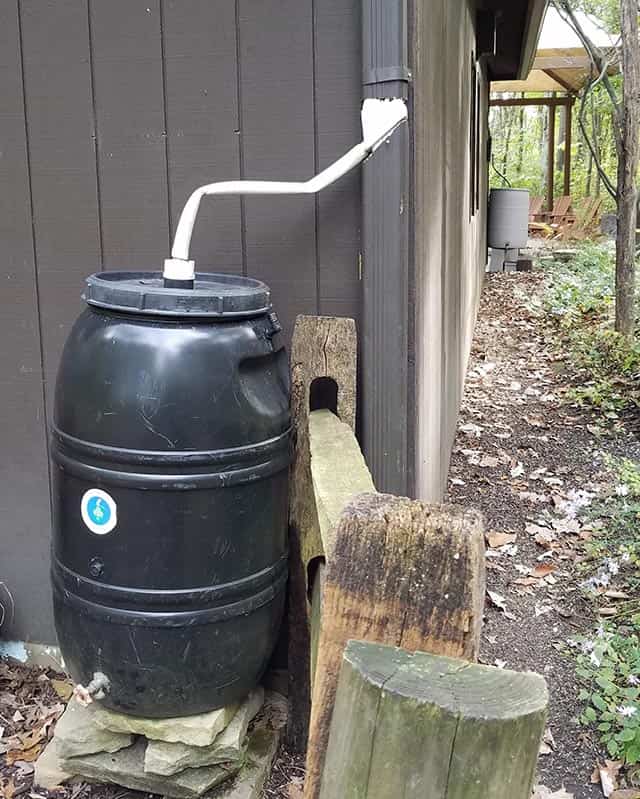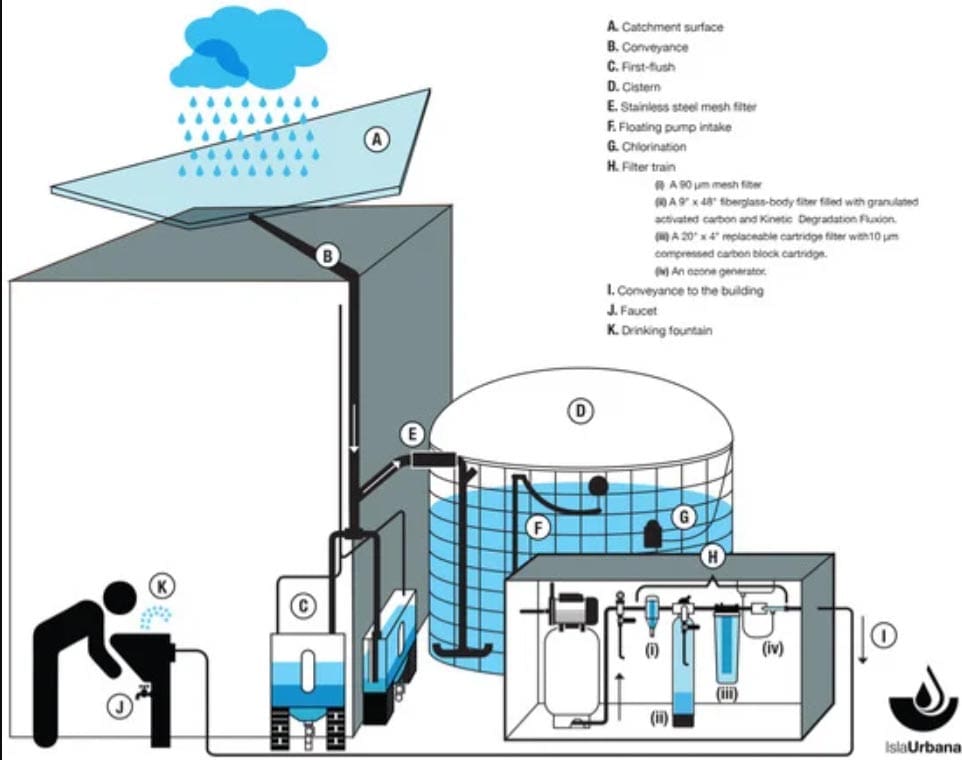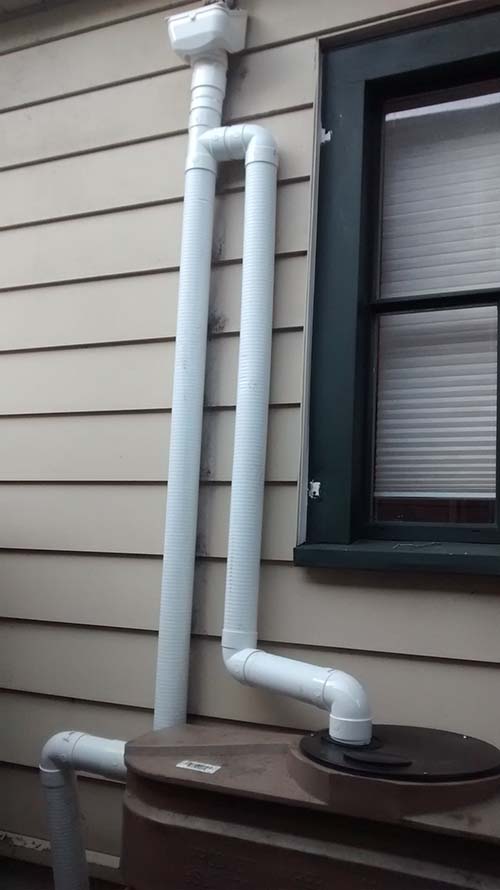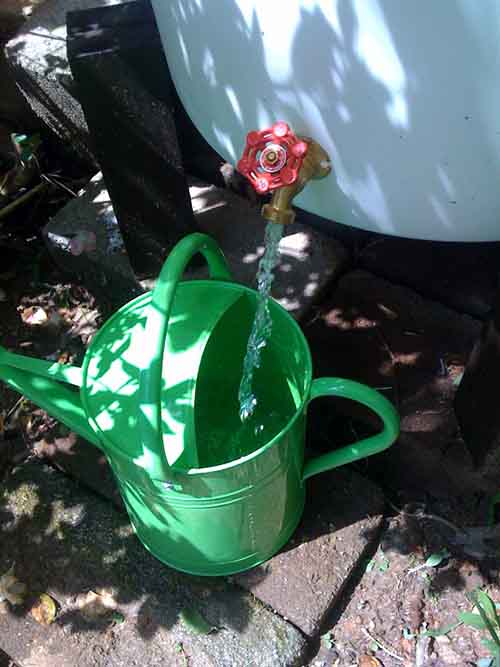Rainwater harvesting has recently gotten very popular, as more people want to conserve water, become self-sufficient, go off-grid, and have a supply of emergency water available.
While rainwater harvesting systems can be very simple and easy to set up, there are still many important things to know before getting started.
This rainwater harvesting guide will go over the basics, including legal issues like permits, types of systems, and costs.
Is Rainwater Harvesting Worth It?

In terms of financial benefits, installing a rainwater harvesting system usually isn’t worth it.
In most places, the cost of water is very cheap. Even if you can significantly reduce your water usage, you’ll still have to pay the water utility’s base rate (which can be quite high), so you won’t save that much money on your water bill. Even with rebates for rainwater harvesting equipment, it could take years or even decades for you to recoup the costs of your system.
Of course, there are exceptions where it might make financial sense to install a rainwater harvesting system. For example, if you live somewhere with drought pricing or if your company uses increasing block pricing, you could save substantial amounts of money by harvesting rainwater.
Rainwater harvesting might also make sense financially if your sewage rates are based on your water usage. Lowering water usage through rainwater harvesting can save you a lot of money on your sewage bill.
Even if it doesn’t make financial sense, there are still many good reasons to harvest rainwater.
Rainwater Harvesting Is Worth It If You…
- Care about conservation
- Use large amounts of water for irrigation
- Want to have a supply of water for emergencies or outages
- Want to live off-grid
- Don’t want to use chlorinated water
- Have very hard water
- Live somewhere drought-prone
- Need to control storm runoff on your property
Ways to Use Collected Rainwater
Rainwater is great for most nonpotable water uses, such as:
- Watering your yard or garden
- Outdoor sinks and rainwater showers
- Washing your car, patio or driveway
- Refilling swimming pools or ponds
Can I Use Rainwater for Flushing Toilets?
Surprisingly, using rainwater for flushing toilets is illegal in many places. To do it legally, you may need to install nonpotable piping, dye the rainwater, and/or disinfect the rainwater first. The rules vary on a county-by-county basis, though, so you’ll have to check your local laws to find out what is allowed.
Can You Drink Harvested Rainwater?
So long as it is properly treated, it is safe to drink rainwater. It is common in many drought-prone places for people to use collected rainwater as their main source of drinking water.
Despite this, using rainwater for potable purposes is still illegal in many places in the United States.

Parts of a Rainwater Harvesting System
Regardless of how small or complex they are, all rainwater harvesting systems have the same main parts. These are:
1. Catchment Surface
In most cases, a rooftop is used to catch the water. However, it is also possible to use other catchment surfaces, such as setting up a tarp to catch rainwater. Some rainwater systems collect runoff from driveways or even the ground itself.
2. Conveyance System
The conveyance system is what brings the rainwater from the catchment surface to the collection container. In most residential rainwater systems, the conveyance system is the gutters.

3. Pre-Treatment and Filters
This part of the rainwater harvesting system helps to keep debris like leaves out of the collected water. There are multiple options, including:
- Gutter screens
- “Leaf eaters”
- Rain barrel diverter
- First flush diverters
- Tank screens (also keep insects and pests out of your rain containers)
*It is recommended that you put a screen over all inlets and outlets on the rain barrels to keep out insects and other pests.
4. Collection Container
After going through the pre-treatment, the rainwater flows into a collection container. There are multiple options, such as rain barrels, totes, tanks, and underground cisterns. You can even collect rainwater in ponds or concrete tanks.
Read:
5. Outlets
Depending on the system, you may need these outlets on your rainwater containers:
- Overflow: Once the rainwater container is full, water exits through the overflow valve to prevent water damage around the barrel
- Spigot or hose connector: This is where you will access the rainwater so you can use it.
- Drain: Some rainwater containers have a drain located near the bottom and a spigot higher up. Because sediment settles at the bottom of the container, you use water from the spigot and use the drain when you need to clean the container.
- Connections: These holes allow you to link multiple rain containers together.

6. Pumps (Optional)
Simple rainwater harvesting systems work on gravity. If the tank is full or very large, you can usually get good water pressure from gravity alone. However, if you need to use the rainwater somewhere far away from the tank, uphill, or indoors, you will need a pump system.
Planning Your Home Rainwater Harvesting System
Is Rainwater Harvesting Legal Where You Live?
Rainwater harvesting is legal in all 50 states. However, some places have laws restricting rainwater harvesting.
For example, Colorado and Utah restrict how much water you are allowed to collect. It’s also common to have restrictions on how rainwater can be used (usually only allowed for irrigating your yard).
Some states have started making laws about how rainwater systems must be built, such as requiring pre-filters and mosquito-proofing.
How Much Do Rainwater Harvesting Systems Cost?
Simple rainwater harvesting systems are usually very cheap. If you are the DIY type, they can be made for under $50.
By contrast, an underground rainwater harvesting system that supplies your home with water can cost more than $20,000 to install.
Costs of Rainwater Harvesting Systems
Below are typical costs of rainwater harvesting system components.
- Containers:
- 50-gallon barrel: $25-$150
- 500-gallon tank: $450 to $600
- 1,000-gallon tank: $500-$1500
- 500-gallon underground cistern: $700-$1000
- 1,000-gallon underground cistern: $1300-$2,200
- Installation:
- Aboveground: $0-$300
- Underground: $50 to $200 per cubic yard of dirt removed
- Pre-treatment:
- Aluminum or steel gutter guards: $0.50-$3.00 per foot (DIY); $7 to $10 per foot (professional installation)
- First flush diverter: $50-$150
- Leaf eater: $25-$60 each
- Pump: $150-$2,000
Other Costs
If your roof or gutters need to be updated, you can expect your rainwater harvesting project to cost a lot more.
People also often forget about the cost of delivery for rain barrels. If you have a flatbed truck, you may be able to pick up the rain barrels yourself. Otherwise, expect to pay a small fortune for delivery.
Rebates for Rainwater Harvesting
Many cities and counties offer rebates to residents for harvesting rainwater. For example, the city of Austin currently offers a rebate of $0.50 per gallon for systems without a pump and up to $1.00 per gallon for systems with a pump (up to half the cost of the system and a lifetime max of $5,000). Other places have programs where they give out free rainwater barrels.
Also, make sure you ask your sewage utility if you get any discounts for harvesting rainwater. This benefit isn’t very common in US states but is offered in many parts of the UK.
How Big Does the Rainwater Harvesting System Need to Be?
The size of your rainwater harvesting system should be based on these four factors:
1. How much water your roof can catch
For example, an average roof has a catchment area of 1,300 sq. feet. For each 1 inch of rain, a square foot of roof will capture approximately 0.45 gallons of rainwater. That means a roof this size could catch 585 gallons of water per moderate shower.
See our rainwater harvesting calculator here.
2. How much rainwater you need
According to the EPA, the average American family uses approximately 50 gallons of water per day for watering their yards and gardens. If you plan on using rainwater for other purposes or have a large yard, you might need more rainwater than this.
3. How often it rains
If you need 50 gallons of rainwater per day and have a 500-gallon tank, you would need it to rain at least once every 10 days.
If it rains more frequently where you live, then you could get away with smaller rain barrels as they would be replenished frequently.
However, if it rains less frequently than this where you live, then you’d need to store larger amounts of rain to meet your needs. Likewise, if you don’t have any other source of water, then you’ll want to have more stored to hold you over.
The downside to catching large amounts of rainwater is that it can grow algae. However, if you live somewhere drought-prone, it might be worth the risk of getting algae to ensure you have a steady supply of water.
4. How much space do you want to dedicate to rainwater harvesting?
Not everyone wants a 1,000-gallon rainwater tank sitting in their yard. The good news about rainwater harvesting barrels is that it is possible to start small and expand your system later by daisy-chaining more barrels together.
And, if you decide that you want to expand your system, you can invest in an underground rainwater storage system.
Do I Have to Filter Rainwater?
If you don’t use a filter on your rainwater barrels, leaves, dirt, bird feces, and other materials can easily get into them.
These materials can because a gross, smelly sludge to form in the barrels. The sludge can get so thick that it clogs the drains. The longer the water sits, the worse the sludge will get.
Rainwater barrel filters do not necessarily have to be complicated or expensive, though. If you clean your gutters regularly and don’t have many trees nearby, then a simple mesh filter over the inlet may be enough.
Above Ground vs. Underground Rainwater Systems
One of the first things to decide before harvesting rainwater is whether you want an aboveground or underground system.
Each system has its pros and cons. As a general rule, though, if you want to harvest large amounts of rainwater for indoor and outdoor use, belowground systems are the better choice.
If you only need a small amount of water for your yard or garden, an aboveground system is more practical.
Above Ground Pros and Cons
Pros:
- Less expensive
- Easy to maintain
- Expandable in size
Cons:
- Can be an eyesore
- Sunlight exposure can cause algae growth
- Subject to freezing
Below Ground Pros and Cons
Pros:
- Don’t take up space in yard
- Not an eyesore
- Maintain a consistent temperature throughout the year
- Protected against vandalism and theft
Cons:
- Expensive to install
- Require excavation
- More difficult to maintain
- Require a pump to access stored water
- Not suitable in all soil types
- May require a building permit



Very informative thank you so much I learned and saved everything and will be utilizing majority of tools given. Thanks
Thanks. Very well layer out. Excellent info.